
May Is Skin Cancer Awareness Month – Find Out Everything About the Condition!
Skin cancer is a frequently seen condition, with an average of 6.1 million people receiving treatment for it each month.
Skin cancer is the out-of-control growth of abnormal skin cells. Skin cancers most often develop due to mutations caused by unrepaired DNA damage caused by UV rays. These mutations can multiply in skin cells rapidly and lead to malignant tumors. The three major types of skin cancer are basal cell carcinoma, squamous cell carcinoma, and melanoma.
Skin cancer develops when mutations occur in the DNA of skin cells. These mutations cause the cells to grow uncontrollably and form a mass of cancer cells. Much of the skin DNA damage leading to skin cancer results from exposure to ultraviolet radiation from sunlight or tanning beds. However, the fact that skin cancers can develop on skin not ordinarily exposed to sunlight indicates the presence of other contributing factors, which can include exposure to toxic substances or conditions that weaken the immune system.
High-risk factors for skin cancer include the following:
The earlier the symptoms of skin cancer are caught, the easier it can be to prevent the condition from getting worse.
Diagnosing skin cancer can be done through skin cancer screening, which involves examining the skin for various suspicious lesions. This includes areas that are often exposed to the sun but also the areas that are usually concealed by clothing. These screenings should be done annually, as skin cancer can progress quickly.
If a suspicious lesion is found, then a skin biopsy is performed and cancer is confirmed, Dr. Ostad might recommend a series of imaging tests, such as CT scans, PET scans, or MRIs, to determine the extent of the cancer.
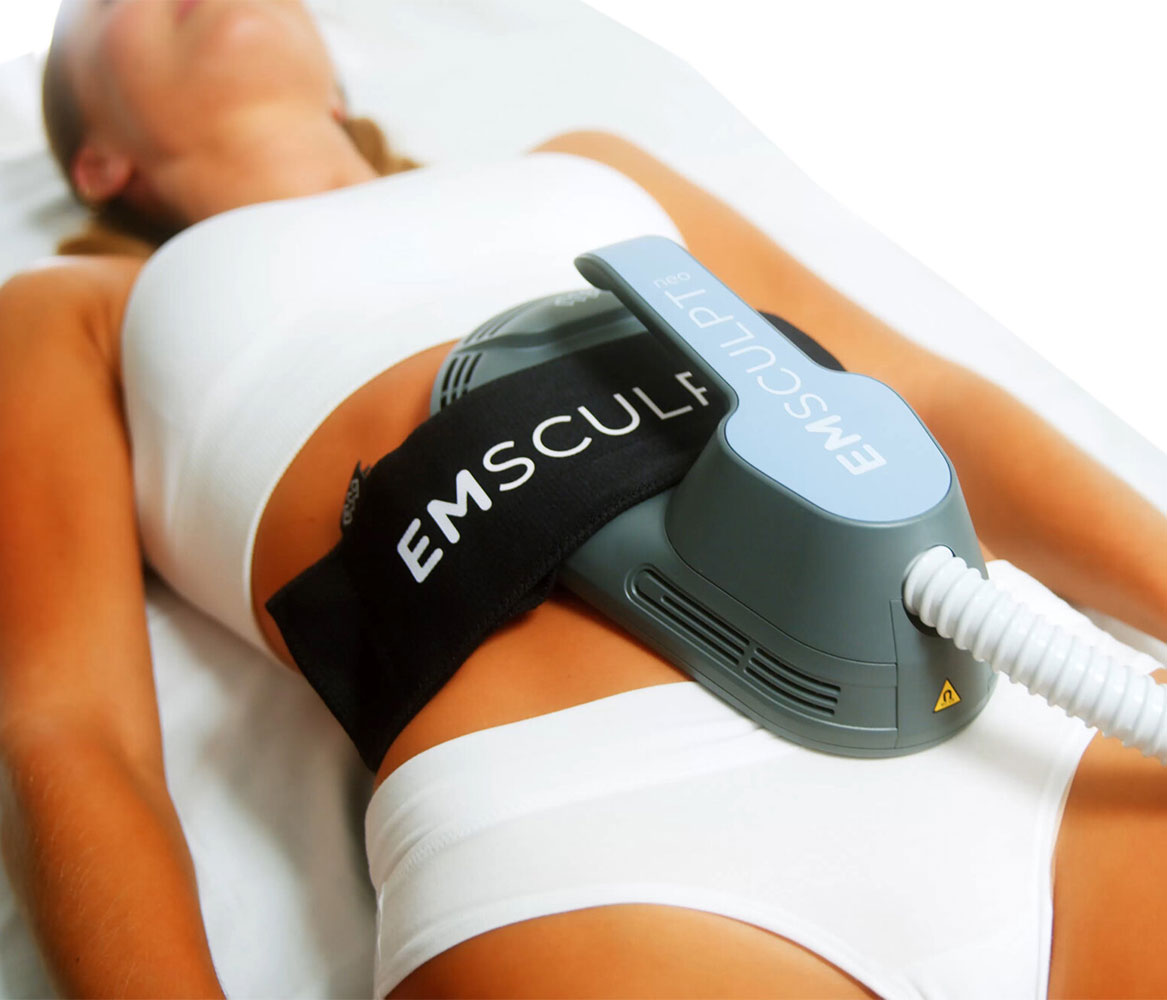
There are many forms of skin cancer. Some are quite deadly if not treated in the early stages, while others spread more slowly and are less likely to be fatal. However, these other forms of skin cancer can be disfiguring. The types of skin cancer include:

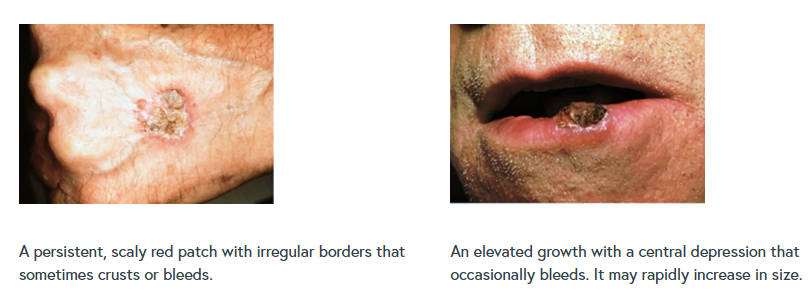

The cure rate for skin cancer is nearly 100% when it is caught early and treated accordingly.
There are many forms of skin cancer. Some are quite deadly if not treated in the early stages, while others spread more slowly and are less likely to be fatal. However, these other forms of skin cancer can be disfiguring. The types of skin cancer include:



The cure rate for skin cancer is nearly 100% when it is caught early and treated accordingly.
Skin cancer might need different treatment approaches, depending on the stage of the cancer as well as its type. A personalized consultation is necessary to determine which treatment option is best for you.
While MOHS surgery is the best treatment option for skin cancer, there are several others to choose from:
Dr. Ostad might choose the surgical or non-surgical route and, in some situations, he might choose a mixture of both. Patients will be advised on the best approach and will be involved in the treatment process.
Approaching skin cancer might vary from one individual to another, based on the stage and type of cancer. That said, Dr. Ostad will go through a series of standard steps from the beginning to the end of the process to ensure that the cancer is diagnosed and treated correctly. This involves the following:
Initial Consultation: Dr. Ostad will ask about relevant factors, such as your medical history along with whether or not there is a history of skin cancer in your family. Patients are encouraged to share as many details as possible, such as concerns about unusual lesions or other relevant skin lesions.
Visual Examination of the Skin: A full-body visual examination will determine whether or not there are any moles or suspicious growths on your body. Dr. Ostad will examine the skin all over the body, even in less obvious areas like the scalp, behind the ears, or on the soles of your feet. Lesions will then be inspected with a dermatoscope.
Biopsy of Suspicious Tissue: If Dr. Ostad finds a lesion deemed suspicious, especially after monitoring it, he may take a biopsy for lab analysis. This can either be a thin layer of the lesion or a full excision.
Treatment Administration: If only a small layer of the tissue has been removed, Dr. Ostad will proceed to surgically remove the suspicious growth. Mohs micrographic surgery is the most common excision procedure. Depending on the stage of the cancer, Dr. Ostad might recommend laser treatments, radiation therapy, and topical medication.
Reconstruction of Healthy Tissue: If a significant amount of tissue has been removed, Dr. Ostad might perform post-surgical reconstruction. Depending on the wound, he may use sutures or grafts to create a balanced area. This stage is particularly important for areas like your face or other sensitive body parts.
Post-Treatment Care: Dr. Ostad will offer immediate instructions on how to take care of the wound and prevent it from being infected. Regular check-ups may be scheduled to make sure the cancer does not return.
Recovery can take anything from a few days to a few weeks or even months, depending on how far the cancer has spread. The earlier you get it treated, the faster you should be on your feet.
The earlier you catch skin cancer, the higher the chances for the treatment to succeed. Even if you develop melanoma (which is the deadliest form of skin cancer), the survival rate is high if you detect it at the first stage. All it takes is one minor surgical treatment, with Mohs micrographic surgery usually being the most effective option.
The earlier you detect the skin cancer, the less likely you will be to undergo aggressive treatments. For instance, if the condition progresses, you’ll have to undergo harsher interventions like radiation, chemotherapy, and highly invasive surgery. When caught early, though, all it usually takes is a minimally invasive procedure, which involves a shorter recovery.
When skin cancer is left untreated, it can spread to other parts of the body, a process referred to as metastasis. If you screen for it and catch the cancer early, it won’t have the chance to spread beyond the skin. This makes it much easier to treat while improving your survival rate.
Skin cancer can make you feel physically sick once you slip into stage 2, which puts your life in danger. By catching and treating it early, your quality of life should be improved, especially since you won’t have as many recovery symptoms to go through.
Treating late-stage cancer can be expensive, mainly because you’ll need more intensive treatments. This is often not necessary if you screen for it early and catch it in the first stage; this is because you won’t have to pay as much for associated treatments.
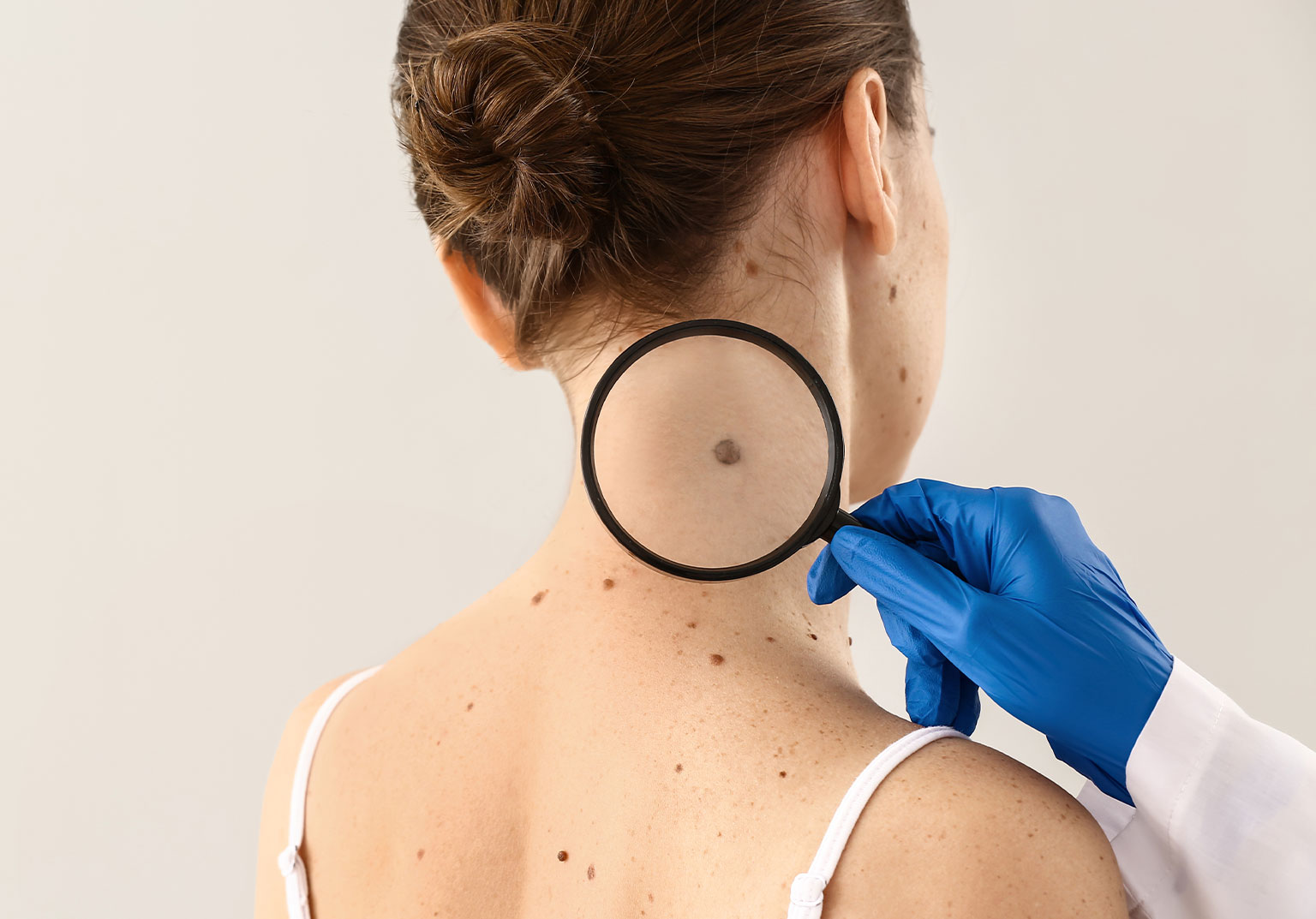
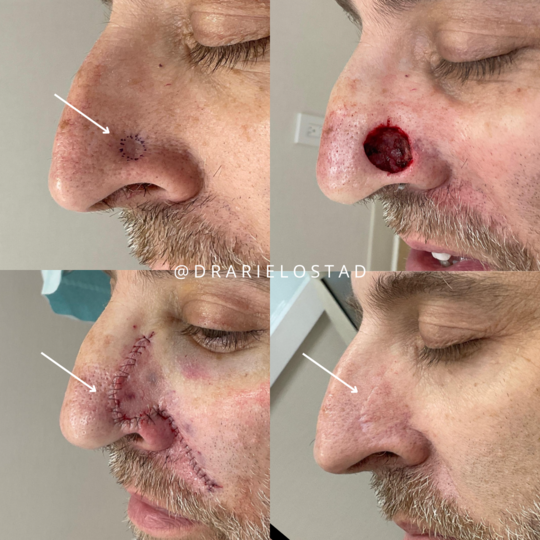
This patient had a Basal Cell Carcinoma on his nose that we treated with Mohs Micrographic Skin Cancer Surgery. These photos show the patient’s 6 month journey from surgery date to fully healed.
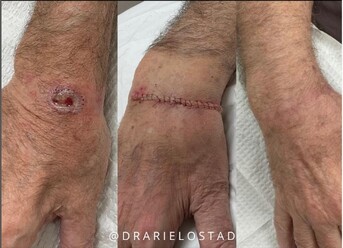
This patient had a Squamous Cell Carcinoma on his right wrist. He had this lesion treated twice without Mohs Surgery at a different physician’s office and it recurred.
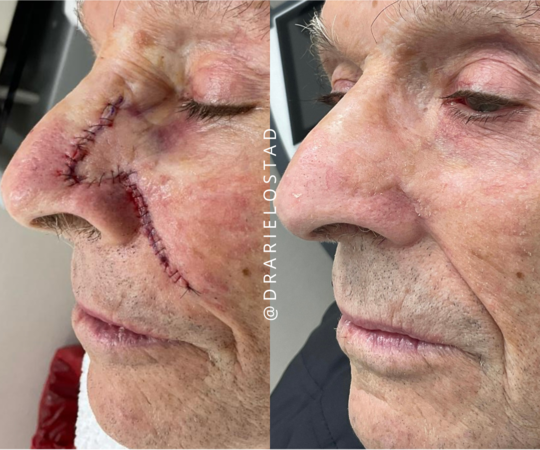
This patient had a Basal Cell Carcinoma on her nose that we treated with Mohs Micrographic Skin Cancer Surgery. Skin cancer reconstruction requires meticulous suturing and awareness of facial anatomy and proper planning to bring the skin together without distorting other facial features. This will result in a well healed minimal scar which will be barely noticeable. These photos were taken 2 years apart and her results are amazing!
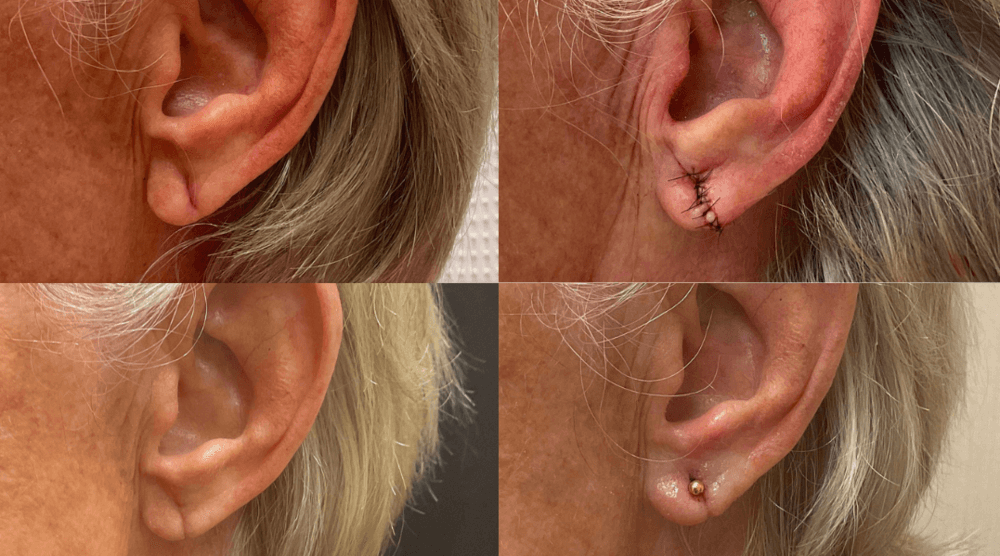
This patient had a Squamous Cell Carcinoma on his nose. In this example, a skin flap taken from the cheek was transferred to cover the area on the side of the nose where the cancer was. The after image shows the results one month after the Mohs surgery was performed.
Skin cancer screening and treatments are mainly used for medical reasons, and they aim to identify and remove potentially life-threatening conditions. However, procedures like Mohs micrographic surgery may also be used to remove pre-cancerous lesions while improving the skin’s aesthetic. The right treatment combination might leave the skin feeling smooth, especially after reconstructive surgery is performed.
“I am extremely impressed and happy with the results of the surgery on my nose. Every part of the process was better than expected, and the outcome has been very good in a very short period of time. I highly recommend Dr. Ostad. As anyone would be, I was very cautious in the beginning. But in just a few weeks post surgery i am so happy with the results that I am actually talking to him about some elective procedures as well. But most importantly, the results of my skin cancer on my nose has been much better than expected.” – Dave
“Dr. Ostad is completely dedicated to his profession and highly skilled. He is the only person I would go to for skin issues on my face. He has performed Moh’s surgery on my nose and chest.. the scars are undetectable. The office is beautifully run. The whole experience takes any worry and anxiety away. Highly recommended.” Marcy J.
“Dr. Ostad did Mohs surgery on my husband’s face. I can’t see where the work was performed. I have been going to Dr. Ostad for Botox and fillers for several years now. I have been to several dermatologists before, none of whom made me look as naturally younger. He has a gentle touch. He uses state of the art equipment for laser and other equipment for body treatments. Dr. Ostad is kind and you never feel rushed at any point there.
The office is both luxurious and Immaculate. The office staff is professional and well mannered. The nursing staff takes the time to address any questions you may have, makes sure you understand all aftercare and will give you whatever is needed for that. They are personable as well which puts you at ease and you feel that they really care about you as a patient and as a human being. They do have a product line which actually works, but you never feel they are “selling” you.
Most important of all Dr Ostad is an artist for your face and body work. I always feel more confident in myself when I leave that office, after all the first judgement of you is your looks. Dr. Ostad improves that.” – Susan Wagner
Between professional screenings, you should monitor your skin for changes or new lesions. The most common signs of skin cancer can be remembered as “ABCDE.” When examining a mole or other lesions, ask yourself if any of the following apply:
The Skin Cancer Foundation reports that approximately 20% of all Americans will develop at least one type of skin cancer over their lifetime. Dr. Ostad encourages patients at his office to perform regular self-checks and undergo professional skin cancer screenings regularly. Often, the trained eye of a dermatologist can identify skin cancers long before you may notice anything, making regular screenings essential. For most patients, an annual screening is sufficient. However, if you are at high risk or have a history of skin cancer, then Dr. Ostad may recommend more frequent screenings.
Generally, skin cancer screening in New York is simple and noninvasive. If Dr. Ostad identifies a suspicious lesion, it will be biopsied. This involves removing a tiny tissue sample and sending it to a laboratory for analysis. If it is diagnosed as cancerous, then treatment will be scheduled immediately. Dr. Ostad performs MOHS micrographic surgery, a precise skin cancer treatment in which cancerous cells are removed one layer at a time. MOHS has the highest cure rate and causes the least amount of cosmetic damage.
While skin cancer can appear in anyone, regardless of their lifestyle choices, a healthy diet and skincare routine can be helpful. Certain antioxidants, such as vitamins E and C, can help protect against damage, supporting overall skin health.
While moles have the highest potential of turning cancerous, skin cancer can take other forms as well. Some skin cancers can appear as a bump or red patch with irregular edges. Other skin cancers look similar to acne, but they are raised nodules or reddish ulcers that do not heal.
Certain skin cancers, such as melanoma, are often dubbed as “silent killers” simply because it can take years, even decades, for them to form. For this reason, sun protection is essential from early childhood years, and suspicious moles should be addressed as soon as possible.
Dr. Ostad is a board-certified dermatologic surgeon and cosmetic provider with his own practice in the Upper East Side of Manhattan, New York City. With more than 20 years of experience in the dermatologic industry, Dr. Ostad is known for his minimally invasive procedures and skin cancer treatments, including Mohs Micrographic surgery. Dr. Ostad has been recognized as a leader in his field, offering advanced and personalized treatment plans that allow his patients to achieve their cosmetic goals. He is known for providing the highest standard of care, using only the latest technologies to ensure his patients receive the best results.
Skin cancer screening and treatment are available at Dr. Ostad’s office in NYC, where he offers personalized treatment plans and top-quality care.
Have More Questions?
If you have questions that have not been answered in this FAQ, you may contact us at our office at any time. We are dedicated to offering you all the information you need so that you can make the correct decision for your health.
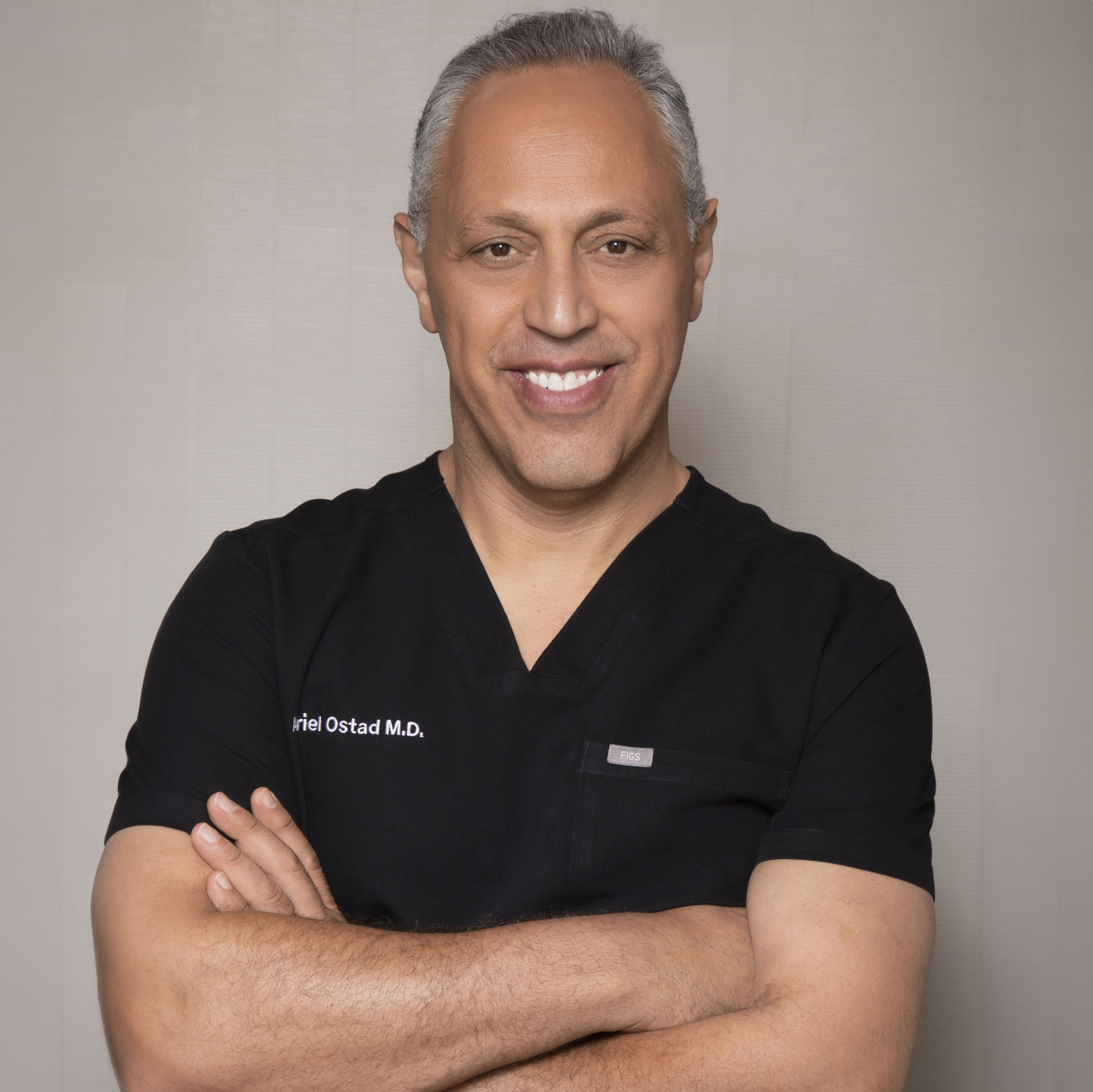
Mohs surgery is primarily used for basal cell carcinoma (BCC) and squamous cell carcinoma (SCC). It may also be used for certain types of melanoma and other rare skin cancers, depending on the case.
Mohs surgery has a very high success rate, with cure rates of up to 99% for new skin cancers and 94% for recurrent ones. This makes it one of the most effective treatments available.
Protect your skin by wearing sunscreen daily, avoiding tanning beds, and seeking shade when outdoors. Regular self-exams and follow-ups with your dermatologist are also important for early detection and prevention.
In the unlikely event that all the cancer isn’t removed during the initial procedure, additional treatments or surgeries may be required. However, the meticulous nature of Mohs surgery makes this rare.
When managing skin cancer, surgically excising the cancerous tissue is not always enough. Often, complementary treatments might be recommended alongside Mohs micrographic surgery to improve skin health and prevent the cancer’s return. For instance, Dr. Ostad might use Fraxel® CO2 laser to remove lingering superficial cancer cells or to eliminate pre-cancerous formations.
Procedures like PicoWay® can also be used for skin rejuvenation after the procedure to eliminate excess pigmentation from the skin. Should a scar remain, Dr. Ostad might recommend scar revision treatments to remove the damaged tissue, therein improving the aesthetics of the skin.
Dr. Ostad believes in a holistic approach to skin cancer, emphasizing the importance of regular screening with long-term skin care. Aside from removing the cancerous tissue, we also offer advice on preventing skin cancer, such as the proper use of sunblock. Additionally, we provide medical-grade skincare, laser, and skin resurfacing treatments that can improve skin quality after skin cancer treatment.
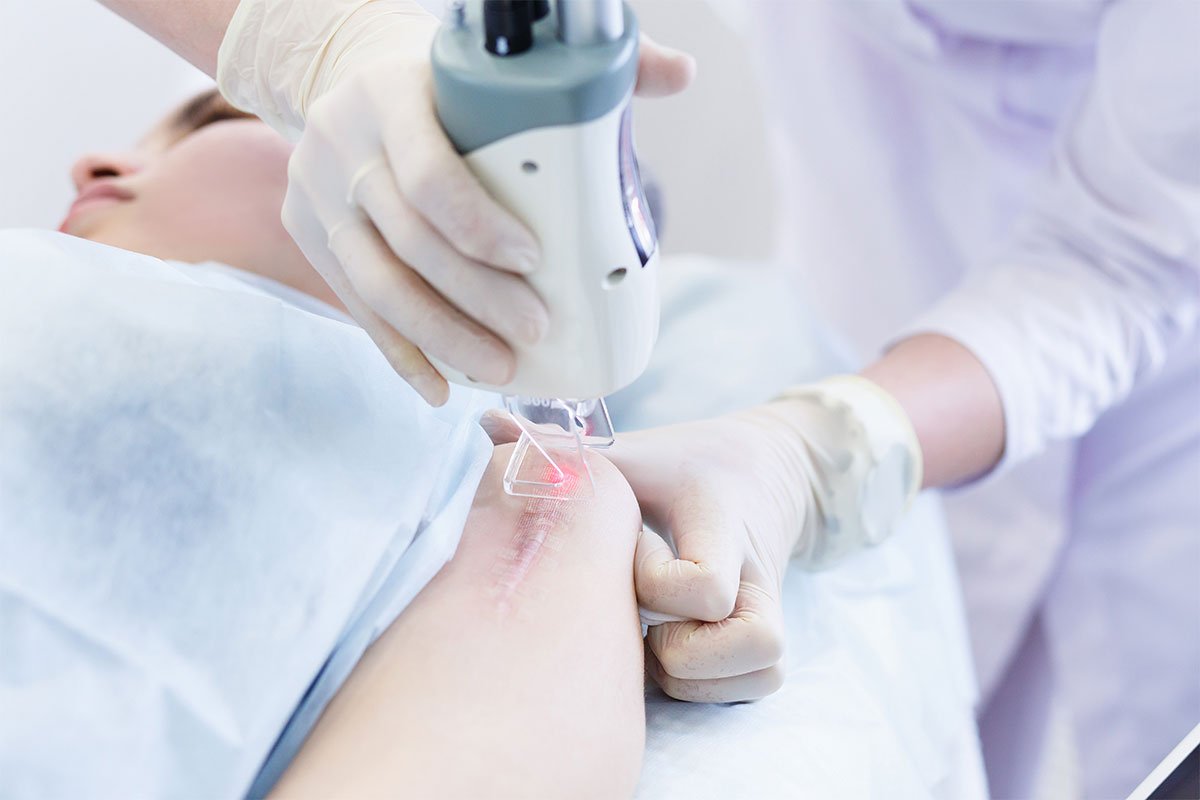
The skin cancer landscape continuously evolves with new technological advancements, improving the cure rate while removing as little healthy tissue as possible. For instance, procedures such as Mohs micrographic surgery take the cancerous tissue away layer by layer until no cancer cells are left. While the cure rate is up to 98 percent, healthy tissue is preserved as much as possible.
Skin cancer professionals may also use procedures like the CO2 or PDT laser to remove lingering cancer cells, which improves the cure rate even more. The excision of the cancerous tissue is done with aesthetic preservation in mind, which is why plenty of treatments feature a restoration stage. Laser-assisted biopsy techniques may also be used to minimize side effects while improving precision.
Nowadays, skin cancer screening and detection tools are used not only for treating existing skin cancer but also for prevention. The newest AI screening technologies allow doctors to efficiently predict the chances of developing skin cancer based on one’s lifestyle. These innovations are particularly convenient for those at risk of recurrence.
Dr. Ariel Ostad is one of the few dermatologists in New York with a triple certification, including Mohs Micrographic Surgery. His skills in dermatology and skin health have led him to receive many honors, including being listed as Top Doctor by Castle Connolly since 2012. Dr. Ostad was also been deemed New York’s Super Doctor in 2024.
Aside from being a skilled professional, Dr. Ostad mentors other residents, teaching them how to perform flawless surgeries. His involvement led him to be named the NYU Dermatologic Surgical Attending of the Year. He has received the award three times.
In addition to his outstanding skills, Dr. Ostad has a compassionate, caring demeanor and a warm, pleasant manner, and he holds great value in his patients’ trust in his abilities and skin cancer treatments.
List of Credentials:
Dr. Ariel Ostad has created a practice in New York that is oriented around patient comfort and care, but safety is also a top priority. For this reason, he maintains strict sanitation, safety, and cleanliness standards.
Over time, Dr. Ostad has invested in numerous lasers and advanced therapeutic devices, frequently updated as technology improves. There’s an on-site lab that Dr. Ostad uses for diagnostics and prepping purposes, including Mohs Micrographic surgery. The practice also has authorization from the AAAASF (American Association for Accreditation of Ambulatory Surgery Facilities) to function as a surgical facility.

Skin cancer is a frequently seen condition, with an average of 6.1 million people receiving treatment for it each month.
Dr. Ariel Ostad has seen patients for this service, including BOTOX in NYC, from all over the tri-state area, including Manhattan, Midtown, the Upper East Side, the Upper West Side, Brooklyn, New York City, the Bronx, Harlem, Astoria, Queens, Long Island, New Jersey, Connecticut, and more. If you are interested in any of the services offered at the Office of Dr. Ariel Ostad, please contact us for more information.
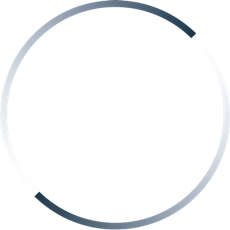
These skincare products combined with your treatment plan customized by Dr. Ostad will help enhance your results and improve your overall skin texture. Click on a product below to learn more.
Dr. Ariel Ostad has seen patients for this service from all over the tri-state area, including Manhattan, Midtown, the Upper East Side, the Upper West Side, Brooklyn, New York City, the Bronx, Harlem, Astoria, Queens, Long Island, New Jersey, Connecticut, and more. If you are interested in any of the services offered at the Office of Dr. Ariel Ostad, please contact us for more information.
By submitting this form you agree to be contacted via phone/text/email.